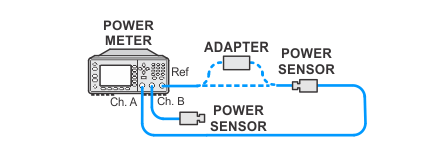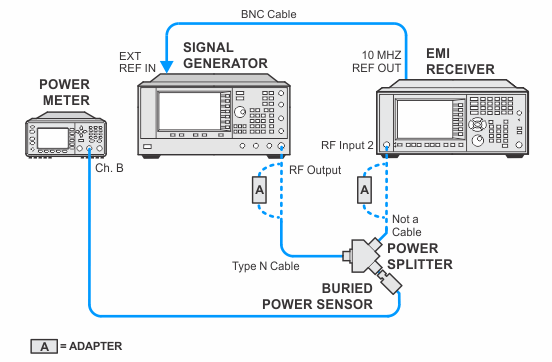
Frequency response (aka. Flatness) is defined as the amplitude deviation from the reference amplitude at 50 MHz. The complete EMI receiver frequency response is measured with several tests. The model and options of the DUT will determine which tests are run from the list below:
This test measures frequency response for AC Coupled (only applicable to Options 503, 508 and 526) and Preamp On/Off in both RF Preselector On/Off mode. The EMI receiver has a second RF input, so the test will be repeated for RF Input 2. The highest frequency for RF Input 2 is 1 GHz.
The E9304A Option H18 power sensor is used in this test. The Preamplifier requires very low input levels (-35 dBm). The E9304A can measure these low levels.
A “buried power sensor” technique is used to characterize the tracking error of a power splitter in order to avoid the relatively large specified tracking error. This technique reduces the measurement uncertainty to verify the frequency response specification for the 50 MHz to 3.6 GHz range. The buried sensor calibration is valid for four hours.
Click here for troubleshooting.
|
Test Equipment |
Model Number1 |
|---|---|
|
Microwave Signal Generator |
PSG Models |
|
Power Meter |
N1914A |
|
RF Power Sensor
|
E9304A Option H18 |
|
RF Power Splitter |
11667A |
|
Cable, BNC |
8120-1840 |
|
Cable, Type-N |
11500C |
|
Adapter, Type-N (f) to 2.4 mm (f)
|
11903B |
|
Adapter, Type-N (f) to 3.5 mm (f)
|
1250-1745 |
|
Adapter, Type-N (m) to Type-N (m) |
1250-1475 |
|
Adapter, Type-N (m) to 3.5 mm (f)
|
1250-1744 |
|
Adapter, Type-N (m) to 2.4 mm (f)
|
11903D |
|



